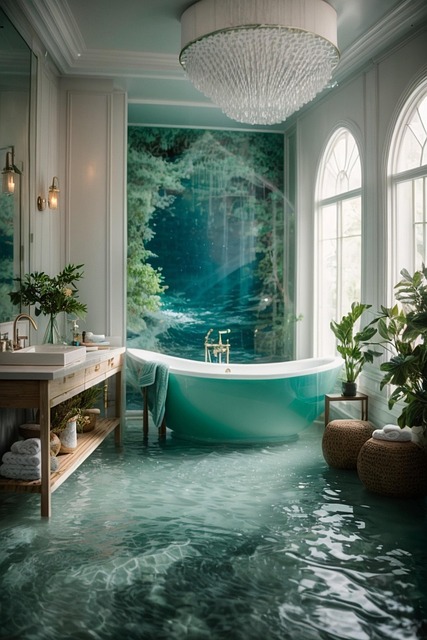LED bathroom lighting emerges as a powerful tool in water conservation efforts, offering up to 75% less energy consumption than incandescent bulbs and minimizing environmental impact. Smart water-saving fixtures integrate this technology, using sensors to activate only when needed, resulting in significant water and energy savings. These innovative devices, featuring customizable lighting options and motion sensors, enhance ambiance while reducing carbon footprints. The future of water conservation looks promising with the growing adoption of LED bathroom lighting and advanced smart fixtures, paving the way for a greener, more sustainable future.
In today’s world, where water scarcity is a growing concern, smart water-saving fixtures are revolutionizing bathrooms. This article explores the role of LED bathroom lighting in conservation efforts, providing a comprehensive overview of these innovative solutions. We delve into their benefits and diverse applications, from efficient irrigation to touchless sensors. Additionally, we examine future trends and the broader environmental impact, highlighting how these smart fixtures contribute to a sustainable lifestyle.
- The Role of LED Lighting in Water Conservation
- Smart Fixtures: A Comprehensive Overview
- Benefits and Applications in Modern Bathrooms
- Future Trends and Environmental Impact
The Role of LED Lighting in Water Conservation
In the pursuit of water conservation, LED bathroom lighting emerges as a powerful ally. These energy-efficient fixtures play a pivotal role in reducing overall water consumption by minimizing the energy required to power them. Traditional lighting methods often lead to higher electricity bills and increased environmental impact due to excessive energy usage. LED lights, however, significantly lower these effects by using up to 75% less energy than incandescent bulbs.
Moreover, LED bathroom lighting’s longevity is a significant advantage. Unlike traditional bulbs that require frequent replacement, LEDs can last for years with minimal degradation in performance. This extended lifespan translates to fewer waste products and further reduces the strain on natural resources, contributing to a more sustainable water conservation strategy.
Smart Fixtures: A Comprehensive Overview
Smart water-saving fixtures are transforming the way we interact with our homes, offering both functionality and sustainability. These innovative devices integrate cutting-edge technologies like LED bathroom lighting to reduce water consumption without compromising on performance. By employing sensors that detect hand movement or contact, these fixtures activate only when needed, minimizing waste from accidental triggers or prolonged use.
LED bathroom lighting plays a pivotal role in this evolution, providing bright, energy-efficient illumination that complements the overall water-saving design. The integration of smart features with LED technology results in significant water and energy savings, contributing to a greener lifestyle. These fixtures are designed for various applications, from low-flow faucets to automated showerheads, ensuring a comprehensive approach to sustainable living.
Benefits and Applications in Modern Bathrooms
Smart water-saving fixtures are transforming modern bathrooms, offering significant benefits for both homeowners and the environment. These innovative solutions incorporate advanced technologies like LED bathroom lighting, which not only reduces energy consumption but also provides a range of customisable lighting options. With motion sensors and intelligent flow control mechanisms, these fixtures ensure water is used efficiently without compromising on performance or user experience.
In today’s eco-conscious world, adopting smart water-saving fixtures is a practical step towards sustainability. They are ideal for contemporary bathrooms, where aesthetics meet functionality. The subtle integration of LED lighting enhances the overall ambiance while reducing water bills and carbon footprints. Whether it’s low-flow faucets that limit water usage without sacrificing pressure or showerheads that adjust flow based on user needs, these fixtures cater to diverse bathroom routines, making every drop count.
Future Trends and Environmental Impact
The future of water conservation looks bright with innovative smart fixtures that seamlessly integrate technology and sustainability. One notable trend is the increasing use of LED bathroom lighting, which offers significant energy efficiency compared to traditional lighting options. This shift not only reduces electricity bills but also minimizes the environmental impact by lowering overall carbon emissions.
As these smart fixtures gain popularity, we can expect to see more sophisticated water-saving technologies in both residential and commercial spaces. From advanced sensor systems that optimize water flow based on occupancy to intelligent irrigation systems for outdoor settings, every drop of water will be carefully managed. This holistic approach to water conservation promises a greener future where resources are preserved for generations to come.
LED bathroom lighting isn’t just a trend; it’s a crucial component of sustainable living. As we look to the future, smart water-saving fixtures like these will play a pivotal role in preserving our planet’s precious resources. By combining advanced technology with eco-conscious design, LED bathroom fixtures offer both style and substance, ensuring a brighter, greener tomorrow for all.
